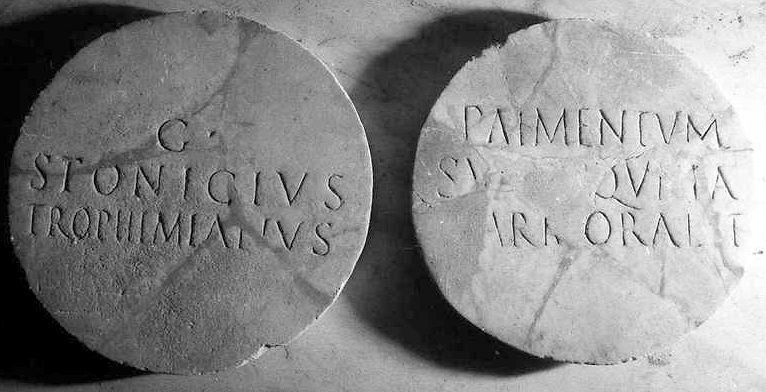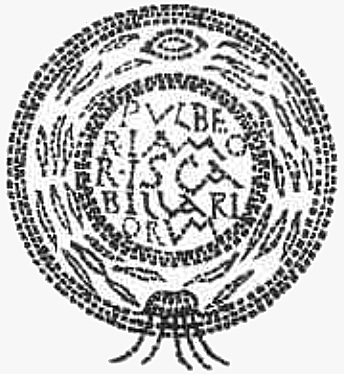The earliest textual reference to an amphitheatre in Puteoli comes from the reign of Augustus:
Spectandi confusissimum ac solutissimum morem correxit ordinavitque, motus iniuria senatoris, quem Puteolis per celeberrimos ludos consessu frequenti nemo receperat. He put a stop by special regulations to the disorderly and indiscriminate fashion of viewing the games, through exasperation at the insult to a senator, to whom no one offered a seat in a crowded house at some largely attended games in Puteoli. Suetonius, Augustus 44,1. Translation J.C. Rolfe. In 66 AD Nero organized a gladiatorial show for king Tiridates in Puteoli, but it was given in the theatre. The amphitheatre may have been damaged by the 62 AD earthquake. Gladiatorial games for Nero in the amphitheatre are mentioned in an inscription (EDR078903). The ruins were identified in 1915 by Vittorio Spinazzola. They are today still mostly buried (when you arrive in Pozzuoli from Naples by train, you will drive right through them). The structure measures 139 x 103.5 meters. Three building phases have been recognized, the first with opus incertum, the second with opus quasi reticulatum, while the third has been deduced from marble decoration. There is no consensus about the date of construction, but it will have taken place in the first century BC. The third phase belongs to the late second or early third century. There are no underground rooms, as usual in early amphitheatres.
Gladiatorial games in this amphitheatre are announced in a painted text from the early first century AD, found in Pompeii:
PAR(ia) XLIX
FAMILIA CAPINIANA MUNERI[bus]
AVGVSTORVM PVG(nabit) PVTEOL(is) A(nte) D(iem) [IV? id(us) Maias]
PR(idie) ID(us) MAI(as) ET XVII XVI K(alendas) IV[n(ias)]
VELA ERVNT MAGVS SCRIPSIT49 pairs.
The gladiatorial family of Capinius will at the Imperial
games in Puteoli fight on 12? May and
16 May and 17 May.
There will be awnings. Magus wrote this.Pompeii, painted text on the Via dell'Abbondanza.
EDR073089. See also CIL IV, 9969, 9970 (venatio et athletae), and 9984a-b.Another painted text from Pompeii, this one referring to nearby Cumae, says: "there will be crucified people, a hunting spectacle, and awnings" (cruciarii, venatio et vela erunt; CIL IV, 9983a). The text brings to mind one of the drawings among the Terracciano graffiti.
On the glass flasks, quite surprisingly, two amphitheatres can be seen. And indeed, there is a second amphitheatre in Puteoli, preserved much better. Spinazzola has suggested that two amphitheatres were kept in existence, because the oldest one was used for gladiatorial games, the later building for games with wild beasts (venationes). The ruins of this second amphitheatre have been used as a quarry for building materials. They were searched in 1839-1855 and 1880-1882, followed by systematic excavations and restorations in the years 1926-1947, and more recent restorations. A detailed description was published by Amedeo Maiuri in 1955.
Click on the image to enlarge.
Plan of the second amphitheatre. Maiuri 1955, fig. 1.
The amphitheatre on a 19th century photo.
Photo: Wikimedia, Roberto Rive.The area around the building could in antiquity be fenced off. The outside measurements of the building are 149 x 116 m., the inside measurements 75 x 42 m. The seating area was made up of numbered cunei, "wedges": CVN(eus) VII, XXII, XXXI and so on. The seats were reached along staircases that were accessible from the exterior and an internal corridor.
View of the exterior.
Photo: Wikimedia, Miguel Hermoso Cuesta.Two sloping ramps for the transport of machines and wild animals led to an underground area that has been preserved exceptionally well. Many fragments of architectural decoration were found here that seem to belong to the building, which, however, may also have been used as a dump in late antiquity. A lime kiln was also found in the building, near which seven statues were found.
View of the underground area.
Photo: Wikimedia, Miguel Hermoso Cuesta.Different building phases have been distinguished, of large stone blocks, opus mixtum and opus latericium. The inauguration is usually assigned to the reign of Vespasianus or Titus, which is why the building is often referred to as the Flavian amphitheatre of Puteoli, while of course "the" Flavian amphitheatre was in Rome. The date has been deduced from at least five fragmentary inscriptions from the building with the text COLONIA FLAVIA AVGVSTA PVTEOLANA PECVNIA SVA: the building was erected by the city of Puteoli at own cost. The letters are 24-39 cm. high.
A dedicatory inscription of the building.
Photo: Il Mattino.Of particular interest is the use of some of the deep, narrow rooms opening up in the facade, below flights of staircases (rooms 1, 6, 10, 59, 60, 64 and 69). In several rooms the walls and floor were decorated with marble. In the back wall may be an apse with a base, in front of the back wall a podium. In room 1 a bench was set against the back wall (h. 0.93, d. 0.83). In the marble floor in front, two round inscriptions were found, recording the installation of the floor at own cost by Gaius Stonicius Trophimianus.

G(aius)
STONICIVS
TROPHIMIANVS
PA(v)IMENTVM
SVA PEQVNIA
MARMORABIT
Marble pavement
of room 1.
EDR074097.
Photo: EDR.Rooms 6 stands out because the barrel vault was decorated with stucco reliefs, reminiscent of the reliefs that are found in tombs.
Stucco reliefs in room 6. The back wall was removed at a later date.
Photo: Maiuri 1995, Tav. XIVa.Room 10 had a mosaic floor with a round inscription of the scabillarii, musicians that we have already encountered in the theatre. It mentions one of them, the beloved Pulveris.

PVLBE
RI AMO
RI SCA
BILLARI
ORVM
Mosaic of the scabillarii
in room X.
EDR074098.
Cf. EDR165729 from Ostia.
Image: Maiuri 1955, fig. 15.It looks as if the rooms were used by groups of people that had some relation with the amphitheatre, to commemorate deceased members, presumably also as shrines with dedications that were placed on a bench or podium.
In the later second or early third century we hear of curatores muneris gladiatorii tridui and quadriduo, curators of gladiatoral games lasting three and four days (EDR160049 and EDR108243). In the same period the mime Pylades, also a local dignitary, organized games of gladiators and a venatio passiva, a mixed hunt, with wild and tame animals (EDR101530).
Walking through the arena and the underground rooms with Guy de la Bédoyère.